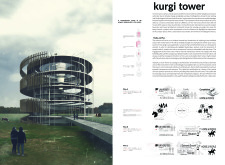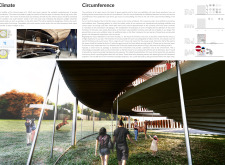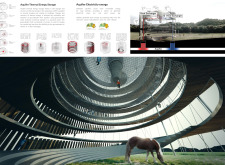5 key facts about this project
The structure is characterized by a spiraling design that allows for fluid movement and an expansive viewpoint, offering opportunities for visitors to observe the surrounding landscape. The use of transparent materials contributes to a sense of connection with the outside environment, fostering dialogue between the architecture and the ecosystem.
Unique Design Elements and Sustainable Features
The Kurgi Tower employs a variety of materials that reflect its sustainable ethos. Wood is utilized for its aesthetic qualities and minimal environmental impact. Steel provides critical structural support while allowing for expansive glass facades that enhance visibility and interaction with the surroundings. Concrete is used strategically for stability in essential areas, while a wire mesh adds a delicate texture to the exterior, maintaining openness while providing necessary protection.
Incorporating aquifer systems for energy generation, the project demonstrates a commitment to renewable resources and climate adaptability. These sustainable energy solutions reduce reliance on traditional power sources, emphasizing the architectural design's focus on ecological balance.
Community Engagement in Architectural Design
The design promotes community involvement through spaces tailored for various interactions. The internal layout encourages collaborative activities, accommodating events, workshops, and exhibitions. User experience is paramount, with the orientation of the building planned to reduce heat gain while maximizing natural light intake.
The orientation and landscaping encourage biodiversity and provide habitats for local fauna, fostering a deeper connection between the community and its environment. These unique architectural considerations contribute to the Kurgi Tower's role as a catalyst for conversations regarding conservation and environmental stewardship.
Explore the project presentation for more details on architectural plans, sections, designs, and ideas that underscore the Kurgi Tower’s innovative approach to architecture and community interaction.


























